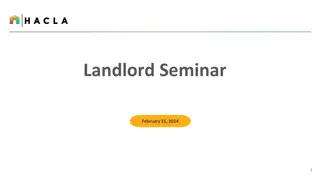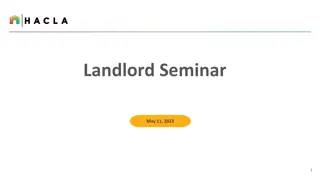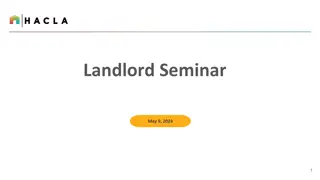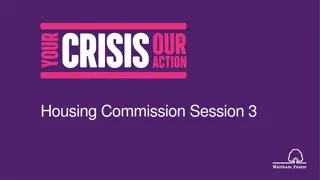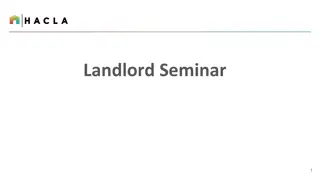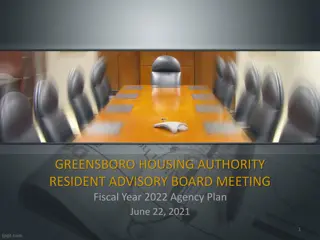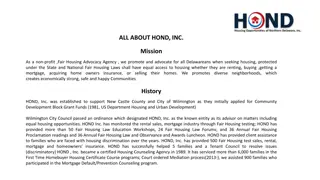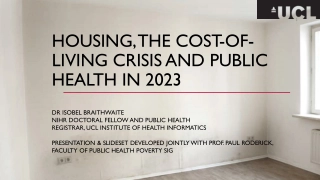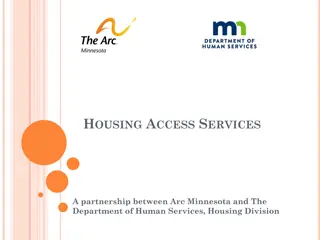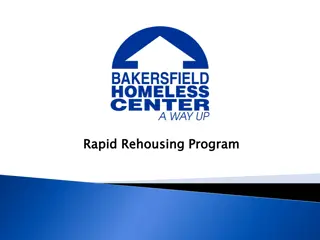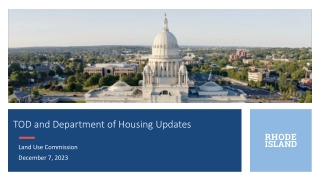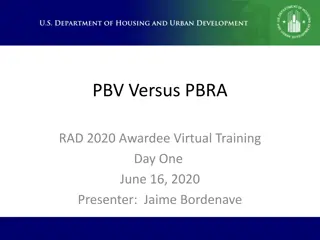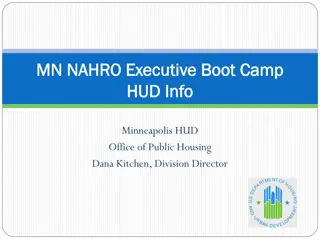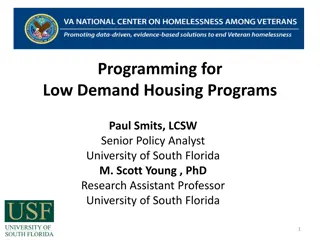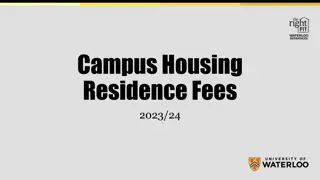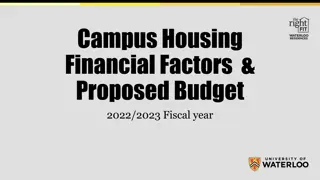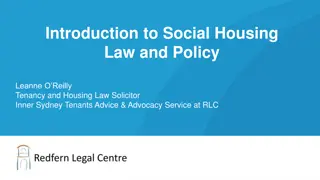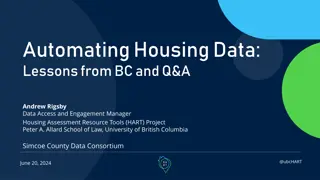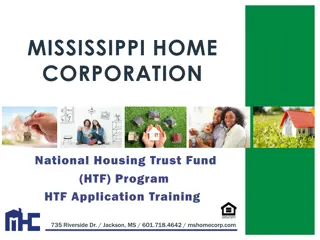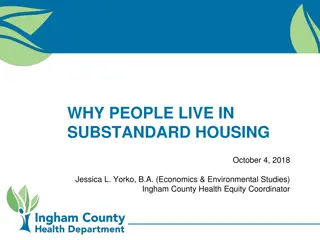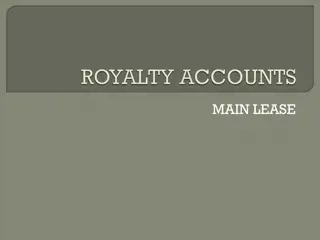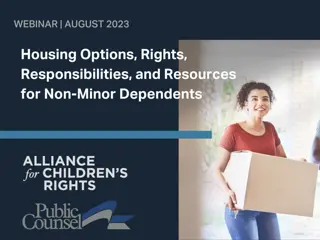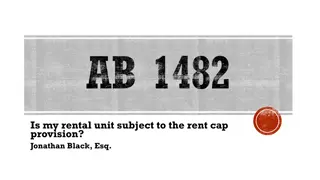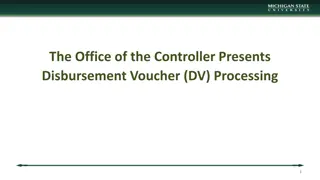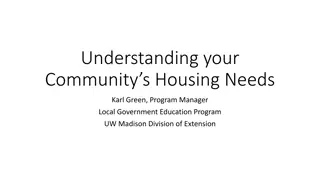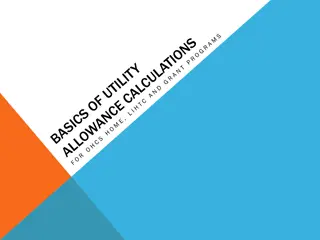Understanding Rent Reasonableness for Housing Voucher Programs
Dive into the world of rent reasonableness in housing voucher programs with this August 25 webinar. Learn from industry experts about considerations, common issues, and best practices to ensure fair rental rates and high-quality units. Discover why setting rents too low or too high can impact families, communities, and program sustainability. Explore essential factors like payment standards, location, unit quality, and negotiation strategies to achieve reasonable rents for all.
Download Presentation

Please find below an Image/Link to download the presentation.
The content on the website is provided AS IS for your information and personal use only. It may not be sold, licensed, or shared on other websites without obtaining consent from the author. Download presentation by click this link. If you encounter any issues during the download, it is possible that the publisher has removed the file from their server.
E N D
Presentation Transcript
Rent Reasonableness August 25, 2022 Webinar
Presenters Judith DeHaven, Director, HCV Quality Assurance Division (QAD) Ray Phung, Program Analyst, QAD Brendan Goodwin, Senior Housing Program Specialist, HCV MOD Kirby McMillan, Quality Assurance Specialist, QAD Andrew Kopacek, Realty Specialist, QAD William Greene, Realty Specialist, QAD
Agenda Rent Reasonableness Overview Considerations for Rent Reasonableness Determinations Quality Assurance Division (QAD) and Rent Reasonableness Reviews Common Issues Found in Rent Reasonableness Reviews Best Practices Questions
Rent Reasonableness Overview Rents Too Low Low success rates Families lose their voucher Administrative Burden for PHA Poor utilization Poor quality units/owners Poverty concentration Diminished Housing Choice Access to well-resourced (opportunity) neighborhoods with good schools, parks, low-crime Rents too High Wasted HCV funds Fewer vouchers available Inflated rents in certain markets/neighborhoods Creates housing instability and affordability issues for lower-income families that do NOT have vouchers
Considerations Rent Reasonableness Payment Standard Landlords may pressure PHA to approve rents at or near the payment standard, even if they are not in line with comparable market rents leads to waste Must be comparing apples to apples Location Quality Size Unit Type Age of unit Amenities Housing Services Maintenance Utilities provided under lease Always consider reasonable accommodations for persons with disabilities Consider Family needs/wants May be willing and able to afford more than payment standard for more amenities, better neighborhood/school system
Considerations (continued) Rent Reasonableness is not a PHA cost-savings strategy It s about attaining reasonable rents and high-quality units, not reducing HAP Negotiation is important, but families also have the option to move Inform the family of their options (pay higher tenant portion if affordability, reasonable accommodation or a move to a more affordable unit) Most important Know Your Market! HUD does not prescribe rent reasonableness methodology/process for flexibility Regularly review your data sources are they up to date? Do you need supplemental data? Review policies and procedures to ensure a consistent and fair assessment and application of rent reasonableness
Resources HCV Guidebook Chapter on Rent Reasonableness Program Regulations 24 CFR 982.507 and 24 CFR 983.303 (PBV) PIH Notice 2003-12 (Requirements for determining comparable rents) PIH Notice 2020-19 (Defining Assisted Units)
Quality Assurance Division (QAD) Rent Reasonableness Overview Quality Assurance Division (QAD) division within the Office of Housing Voucher Programs mandated by Congress with the oversight of the Housing Choice Voucher Program Rent Reasonableness Team ensure compliance with Rent Reasonableness provisions of the HCV program 3 Member Team Review territories split based on geographical areas While reviews can result in findings, largely Technical Assistance focused
Quality Assurance Division (QAD) Rent Reasonableness Team Reviews consist of two types Portfolio Reviews Comprehensive Review PHAs chosen based on variety of risk factors Rent Level Analysis from Portfolio Reviews Risk/Performance (SEMAP) Referral from Field Offices or OIG
QAD Rent Reasonableness Review Types Portfolio Reviews Goal: Analyze and determine whether program rents charged exceed/fall below market rent Conducted remotely Based on 50058 submitted data (PIC) on Contract Rent Informs risk and need for further Comprehensive Review Results generally not shared with PHA
QAD Rent Reasonableness Review Types What Triggers a Comprehensive Review??? Based on the result from a Portfolio Review: If the average HCV rent exceeds the 103% weighted average for any bedroom size If the average HCV rent is far below (40%+) the average market rent for any bedroom size If a conclusive analysis cannot be arrived at due to insufficient market data typically a very rural area
QAD Rent Reasonableness Review Types Comprehensive Review Goal: Determine whether policy, procedures, and methodology of PHA s rent reasonableness system is reasonable, and whether these practices are applied consistently Conducted both Remotely and On-Site Review PHA s Administrative Plan and other written policies/procedures Selects sample of tenant files to review Rent Reasonableness determination documents e.g. RFTA, RR Forms, Requests for Rent Increases Review PHA RR Source Documents, External Sources PHA and Field Office receive copy of report
Rent Reasonableness Reviews: Common Issues Adequate consideration of the 3 most important criteria: Location, Bedroom Size, Unit Type BR size & unit type sometimes don t match. Timing of the RR certification. RR is documented as done after the HAP Contract is signed (should always be done before the HAP Contract is signed).
Rent Reasonableness Reviews: Common Issues Approved rent level. Approved rent is higher than the comparable units, and this variance is not accounted for by differences in landlord-provided utilities and/or in other criteria that greatly affect rent values Comparable unit problems Old comparable used Database not regularly updated Point or formula-based RR systems that have no basis in the real estate market
Rent Reasonableness Reviews: Best Practices PHA staff attending basic real estate appraisal training The same principles apply to estimating market rent. Helps staff improve the accuracy and efficiency when estimating RR Staff that review comparable units selected by automated estimate program should have the capacity to override the automated system when the system selects noncomparable properties. Subscribing to a local real estate research company for data.
Rent Reasonableness Reviews: Best Practices PHA developed their own market rental data system. Employees collect contact information from signs advertising houses or apartments for rent. Contact Landlords for details on the property. Update the data by contacting the landlords 6 months to a year later. Compile the data into organized computer files or 3 ring binders by location, unit type and bedroom size. For county or state PHA s, database organized by city, unit type and bedroom size.
Rent Reasonableness Reviews: Best Practices Use spreadsheets showing side-by-side comparison of comparable data Use of small dollar adjustments or percentage adjustments when comparing comps to the subject HCV unit Individual comparable data sheets addressing the 9 factors of consideration on one page Utilizing Unit-to-Market methodology, where applicable
Rent Reasonableness Webinar Questions via chat and phone Follow-up questions and Requests for TA can be sent to: HCV_QAD_RR@hud.gov



